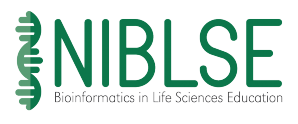Resources
Developing a phylogram from computational resources.
Author(s): Melanie Lenahan1, Shea Cinquemani1
Raritan Valley Community College
876 total view(s), 1875 download(s)
Description
Introductory bioinformatics exercises often walk students through the use of computational tools, but often provide little understanding of what a computational tool does "under the hood." A solid understanding of how a bioinformatics computational algorithm functions, including its limitations, is key for interpreting the output in a biologically relevant context. This introductory bioinformatics exercise integrates an introduction to web-based sequence alignment algorithms with models to facilitate student reflection and appreciation for how computational tools provide similarity output data. The exercise concludes with a set of inquiry-based questions in which students may apply computational tools to solve a real biological problem.
In the module, students access text-based FASTA-formatted sequence information via National Center for Biotechnology Information (NCBI) databases as they collect sequences for a multiple sequence alignment using Clustal Omega to generate a phylogram and evaluate evolutionary relationships. The combination of diverse, inquiry-based questions, paper models, and web-based computational resources provides students with a solid basis for more advanced bioinformatics topics and an appreciation for the importance of bioinformatics tools across the discipline of biology.
CourseSource Citation
Kleinschmit, A., Brink, B., Roof, S., Goller, C., and Robertson, S.D. 2019. Sequence Similarity: An inquiry based and “under the hood” approach for incorporating molecular sequence alignment in introductory undergraduate biology courses. CourseSource. https://doi.org/10.24918/cs.2019.5
Notes
- Exercise Format
- This adaptation was piloted in a General Biology course and subsequently revised by a student from that class. The purpose of the adaptation was to make the module more student friendly and cohesive.
- Copy edits and text and activity choice modifications
Reference
Kleinschmit, A., Brink, B., Roof, S., Goller, C., and Robertson, S.D. 2019. Sequence Similarity: An inquiry based and “under the hood” approach for incorporating molecular sequence alignment in introductory undergraduate biology courses. CourseSource. https://doi.org/10.24918/cs.2019.5
Cite this work
Researchers should cite this work as follows:
- Lenahan, M., Cinquemani, S. (2021). Developing a phylogram from computational resources.. Bring Bioinformatics to Your Biology Classroom, QUBES Educational Resources. doi:10.25334/DP07-5Q37

